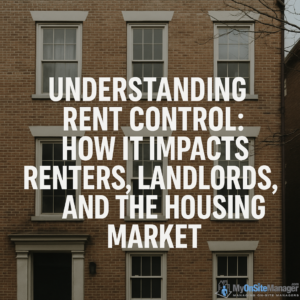Rent control is a policy designed to regulate the cost of renting a home, ensuring affordability for tenants in cities where housing demand outpaces supply. While the idea of keeping rental costs manageable seems beneficial, rent control policies can have far-reaching consequences that affect tenants, landlords, and the overall housing market.
In this article, we’ll explore what rent control is, its potential benefits and drawbacks, and its impact on various housing markets worldwide.
What Is Rent Control?
Rent control refers to laws that limit how much landlords can charge for rent and how frequently they can increase rental prices. The goal is to protect tenants from steep rent hikes and provide stability in housing costs. However, these regulations vary widely depending on the city, state, or country where they are enacted.
There are two primary types of rent control:
1. Strict Rent Ceilings
Strict rent control laws impose a maximum limit on how much landlords can charge for rent, regardless of market demand or inflation. This type of rent control is rare because it significantly reduces a landlord’s ability to adjust prices in response to changing market conditions.
2. Rent Stabilization
Rent stabilization allows for controlled increases in rent, usually tied to inflation or a set percentage. This provides a balance between tenant protection and landlord profitability. Many cities with rent control, such as New York City, implement rent stabilization rather than strict ceilings.
How Rent Control Affects Tenants
1. Affordable Housing
One of the biggest advantages of rent control is that it helps keep rental prices affordable. For tenants in high-cost areas, rent control can provide significant financial relief, ensuring they don’t get priced out of their homes due to rising market rates.
2. Increased Housing Stability
By limiting rent increases, tenants are less likely to face sudden evictions due to unaffordable hikes. This leads to more stable communities where residents can establish long-term roots.
3. Protection Against Displacement
Gentrification can lead to the displacement of long-term residents as newer, wealthier tenants move in and drive up rental prices. Rent control helps mitigate this by capping rent increases, allowing existing tenants to remain in their neighborhoods.
How Rent Control Affects Landlords
1. Reduced Incentives for Maintenance and Repairs
With rent limits in place, landlords may find it less financially viable to maintain or upgrade their properties. Over time, this can lead to a decline in housing quality, as landlords defer maintenance costs to preserve profitability.
2. Limited Returns on Investment
Real estate investors typically expect rental income to increase over time to keep up with inflation and rising costs. With rent control in place, their return on investment may be lower, making property ownership less attractive.
3. Incentive to Convert or Sell Rental Units
In cities with strict rent control laws, landlords may choose to convert rental properties into condominiums or sell them instead of dealing with rent restrictions. This can decrease the availability of rental housing, which contradicts the policy’s intent of increasing affordability.
The Unintended Consequences of Rent Control
While rent control aims to provide affordable housing, it can sometimes lead to unintended negative effects, including:
1. Reduced Housing Supply
Landlords may choose to exit the rental market by converting apartments into owner-occupied condos or short-term vacation rentals. This ultimately leads to a decrease in rental inventory, making it even harder for tenants to find affordable housing.
2. Black Market Rentals
In some cities with strict rent control, tenants sublet their apartments at higher rates to profit from their artificially low rent. This creates a black market for rental housing, where new tenants end up paying more than they should.
3. Housing Mismatches
Long-term tenants benefiting from rent control may occupy larger apartments than they need, while families looking for bigger units struggle to find available housing. This inefficiency makes it difficult for housing to be allocated based on need.
Case Studies: Rent Control in Different Cities
1. San Francisco, USA
San Francisco’s rent control laws have been in place for decades, covering many older apartment buildings. However, studies have found that while tenants in rent-controlled units benefit, overall rental prices have risen due to reduced supply. Many landlords converted rental units into condos to avoid regulations, leading to a tighter housing market.
2. Berlin, Germany
Berlin implemented strict rent control policies in 2020, capping rental prices to prevent excessive increases. However, landlords found loopholes by offering furnished apartments at much higher prices. Additionally, rental housing construction slowed down because developers were discouraged by the regulations.
3. Buenos Aires, Argentina
Buenos Aires had strict rent control laws for many years, leading to a shortage of rental units. When these laws were relaxed, more rental properties became available, and competition helped stabilize rental costs.
Balancing Rent Control with Market Needs
For rent control policies to be effective, they must strike a balance between protecting tenants and ensuring that landlords have enough incentives to maintain and offer rental housing. Some alternative approaches that cities have adopted include:
- Incentivizing New Housing Development: By providing tax breaks or subsidies, governments can encourage developers to build more affordable rental housing.
- Offering Tenant Assistance Programs: Direct rental assistance for low-income tenants can help them afford housing without distorting the market.
- Implementing Rent Control with Exemptions: Some cities apply rent control only to older buildings, allowing new developments to operate under market conditions.
Conclusion: Is Rent Control the Right Solution?
Rent control remains a highly debated topic in housing policy. While it offers immediate relief to tenants, it also presents long-term challenges that can lead to housing shortages and reduced property maintenance.
For policymakers, the key is to find a middle ground—protecting tenants from extreme rent increases while ensuring that the rental market remains healthy and sustainable.
Source: What Is Rent Control and How Does It Affect Your Rent Payments?

